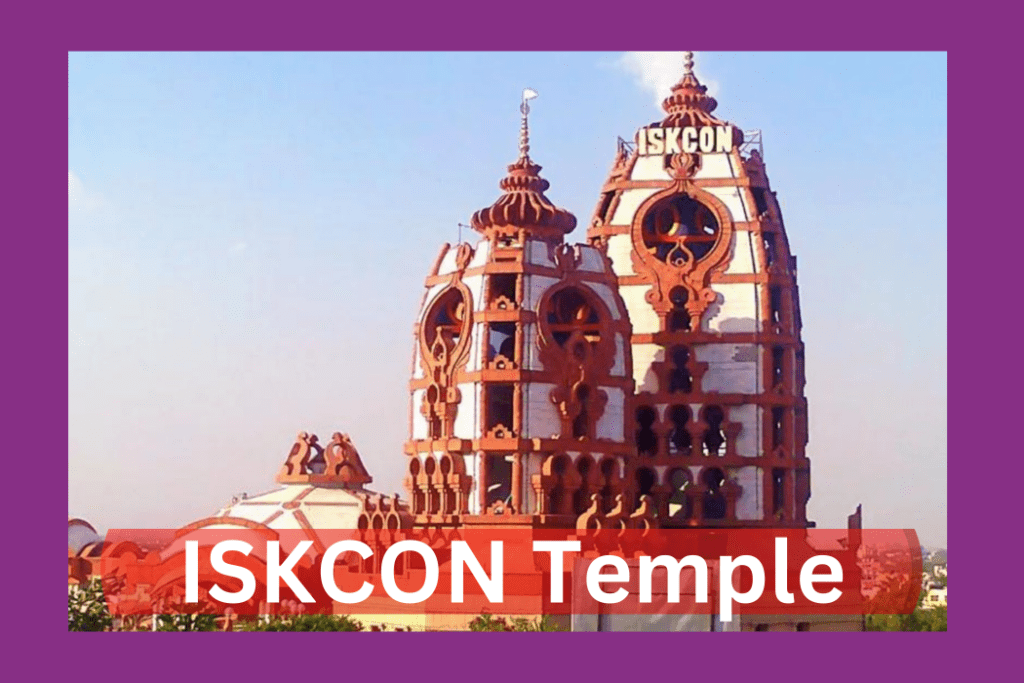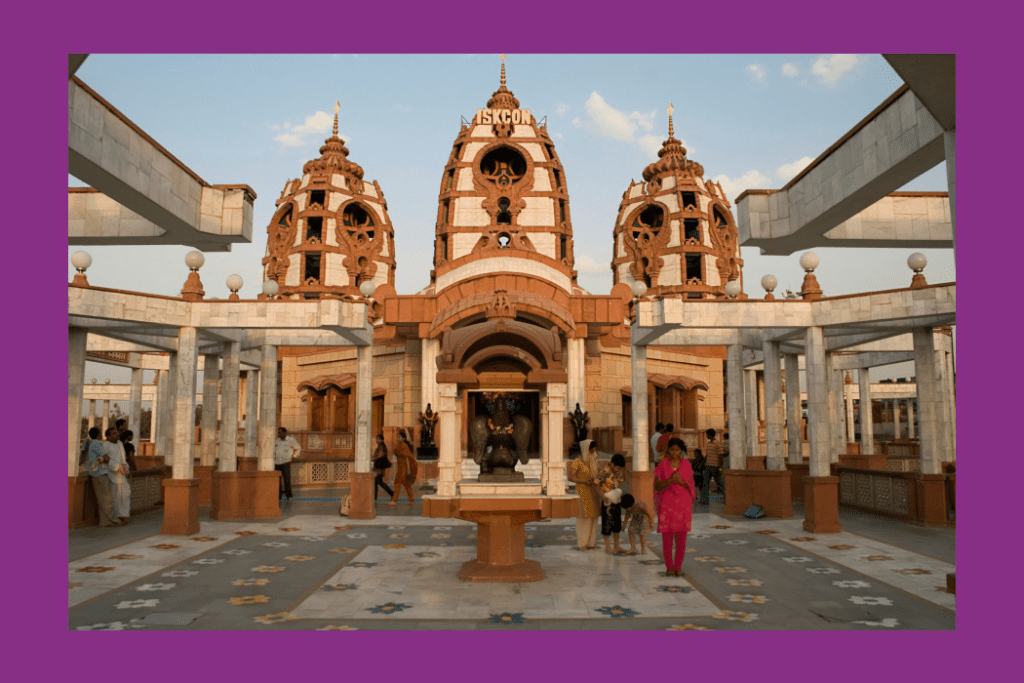ISKCON Dwarka Temple, Delhi: History, Significance, and Travel
is blog discusses the history, architecture, fantastic destinations, and tranquillity that make ISKCON Dwarka Temple an excellent choice for a visit.

ISKCON Dwarka Temple: On Devi Road in Dwarka stands a lovely ISKCON temple honouring Lord Krishna and his consort, Radha. This ISKCON Dwarka Temple, unlike others, is constructed completely from stone and exudes a tranquil and sophisticated ambiance. The ambiance is calm and sophisticated, encouraging reflection and spiritual connection.
You have the option to explore the temple for meditation, participate in the customary aarti rituals, and appreciate the unique design. There is also a guest house close by in case you require accommodation.
This blog discusses the history, architecture, fantastic destinations, and tranquillity that make ISKCON Dwarka Temple an excellent choice for a visit.
| Participate in online puja organised by VAMA(Get the puja done with your name and gotra) | |
| Name of Puja | Temple (Place) |
| Rin Mukti Puja | Rin Mukteshwar Mahadev Temple (Ujjain) |
| Shani Sade Sati | Shani Shingnapur Devsthanam ,Maharashtra |
| Rahu Grah Shanti Puja | Jarkutinatheshwar Mahadev Temple,Prayagraj |
| Bal Gopal Santaan Prapti Puja | Vrindavan Dham Kshetra ,Vrindavan |
| Sunderkand Path Rasraj Ji Maharaj ke sath | Lete Huye Hanuman Mandir, Prayagraj |
Read this Blog to know about Alopi Devi Temple – Alopi Devi Mandir, Prayagraj: History, Significance, and Travel
History and Story Behind ISKCON Dwarka Temple
Dwarka has a rich past as a sacred destination for pilgrimages, referenced in ancient Hindu scriptures like the Mahabharata and Puranas. Despite having a longer history, the famous ISKCON temple in Delhi didn’t open officially until April 5th, 1998. The impressive design was created by the famous architect Padma Shri Achyut Purushottam Kanvinde, who received the Padma Shri award in 1974.
Collaboration with The Hinduja Foundation was necessary for the construction of the temple. At first, their goal was to finish the project by December 1995. Funding for the construction of the grand temple, totaling 12 crore rupees, was mainly provided by donations from Delhi and various other regions of India.

Ever since its founding, the ISKCON Dwarka Temple has drawn in people seeking spirituality and followers of Krishna from around the globe. The increase in tourists has greatly enhanced religious tourism in Dwarka, boosting the city’s economic and cultural vitality. The temple continues to attract many people looking for spiritual experiences and delving into Krishna consciousness, adding to the historical and cultural importance of the city.
Architecture of ISKCON Temple
The ISKCON Dwarka Temple in Delhi stands as a unique blend of traditional Hindu temple architecture, incorporating elements of different styles. Crowning the Hare Krishna Hills, the main temple features latticed wall towers and boasts a construction using marble, wood, and carved stone. The main temple is the heart of the complex, housing the central idols and witnessing daily rituals and prayers.
Dedicated to scholarly pursuits, the vedic centre section houses various halls for seminars, classes, and conferences on Vedic philosophy. Additionally, it treasures a library named The Library of Vedic Research, containing a vast collection of Vedic literature in various languages, including those beyond India.
Facing the temple, the open-air museum serves as a platform for showcasing traditional music and dance performances, adding a vibrant touch to the spiritual experience.
This museum, also called the Glory of India Vedic Cultural Centre, uses multimedia technologies to showcase ancient Hindu scriptures in an engaging way. Discover a variety of oil paintings by ISKCON Dwarka Temple devotees worldwide, depicting their creative reflections on the Ramayana.

Spiritual Significance and Festivals
Hinduism, an energetic faith with a diverse array of customs, observes various festivals all year round. Every festival has its own importance, showcasing tales, gods, and principles that are highly meaningful to believers. Below is a more detailed examination of certain significant Hindu celebrations discussed, providing insight into their distinct attributes.
Krishna Janmashtami: Cultural performances such as dance dramas and storytelling sessions narrate stories about Krishna’s life, his fights against wickedness, and his lessons. Night is the most important time.
Holi: Individuals excitedly throw colourful powder (gulal) and water on one another, generating a lively presentation. The main idea is the success of goodness against wickedness, represented by Lord Krishna defeating the demon king Holika.
Holi also involves overcoming fears and promoting unity among people.
Guru Purnima: The chanting of the Hare Krishna Maha-mantra is a significant part of the Gaura Purnima festivities.
The importance of “The Great Chant of the Holy Names of Krishna” in Vaishnavism lies in its perceived efficacy in attaining spiritual freedom.
During the night, the temples fill with the echoes of chanting and kirtans, producing a mystical and uplifting environment.
Radhastami: Radhastami commemorates the birth of Radha, who represents true love and dedication as Krishna’s eternal partner. Her devotion to Krishna goes beyond earthly boundaries, setting an example for others embarking on a spiritual path.
On the occasion of Radhastami, Radha temples are decorated with flowers while followers recite prayers and perform devotional songs.
Diwali: This celebration highlights the significance of removing darkness from our lives, whether it be physical or symbolic. Followers engage in puja through performing rituals and seeking blessings for wealth and spiritual wisdom. During Diwali, families come together, swap presents, savour delicious sweets and dishes, and watch fireworks.
Tourist attractions around the ISKCON Dwarka Temple
Here’s a look at some cool spots near the ISKCON Dwarka Temple:
The Lotus Temple: This stunning building with gardens looks like a lotus flower. It welcomes people of all faiths for prayer and meditation. The nine white marble petals symbolise unity between religions. Inside, the peaceful hall filled with sunlight creates a calming atmosphere. The unique design earned it a UNESCO World Heritage Site status!
Kalkaji Mandir: During festivals like Durga Puja, the temple comes alive with decorations, chants, and strong devotion. Witnessing rituals and the faith of devotees offers a glimpse into the rich Hindu traditions.
Aastha Kunj Park: Looking to escape the hustle and bustle of the city? This sanctuary located between ISKCON and the Lotus Temple is your safe haven. Stroll on winding trails, appreciate vibrant flowers, or unwind on the grass with a picnic.
National Zoological Park: Visit the National Zoological Park, located approximately 4 km away, for an incredible experience with animals. Witness tigers, monkeys, elephants, and other animals from different countries! Also, educate yourself on the zoo’s conservation initiatives.
Nehru Planetarium: Interested in learning about the universe? This planetarium, located 5 kilometres from here, offers presentations, displays, and discussions on topics like the solar system, star patterns, and recent space findings. Entertaining for individuals of all age ranges!
How to Reach the ISKCON Dwarka Temple?
By Air: The closest airport is Indira Gandhi International Airport, situated approximately 15 kilometres from here.
Using the train: NDLS is the biggest and most active train station in Delhi, situated approximately 12 kilometres away from ISKCON Temple.
Travelling by bus: The temple is located approximately 2 kilometres from the nearest bus stop at Mahalakshmi Layout Entrance. You have the option of using a bus from different areas of Delhi to get to this station.
Frequently Asked Questions
What is the significance of ISKCON Dwarka Temple?
Hinduism, an energetic faith with a diverse array of customs, observes various festivals all year round. Every festival has its own importance, showcasing tales, gods, and principles that are highly meaningful to believers.
What is the story of ISKCON Dwarka Temple?
Dwarka has a rich past as a sacred destination for pilgrimages, referenced in ancient Hindu scriptures like the Mahabharata and Puranas. Despite having a longer history, the famous ISKCON temple in Delhi didn’t open officially until April 5th, 1998. The impressive design was created by the famous architect Padma Shri Achyut Purushottam Kanvinde, who received the Padma Shri award in 1974.
How is the Architecture of ISKCON Dwarka Temple?
The ISKCON Dwarka Temple in Delhi stands as a unique blend of traditional Hindu temple architecture, incorporating elements of different styles. Crowning the Hare Krishna Hills, the main temple features latticed wall towers and boasts a construction using marble, wood, and carved stone. The main temple is the heart of the complex, housing the central idols and witnessing daily rituals and prayers.
Want to know about Bhimashankar Jyotirlinga? Read this blog – Bhimashankar Jyotirlinga, Pune: History, Significance, and Travel




